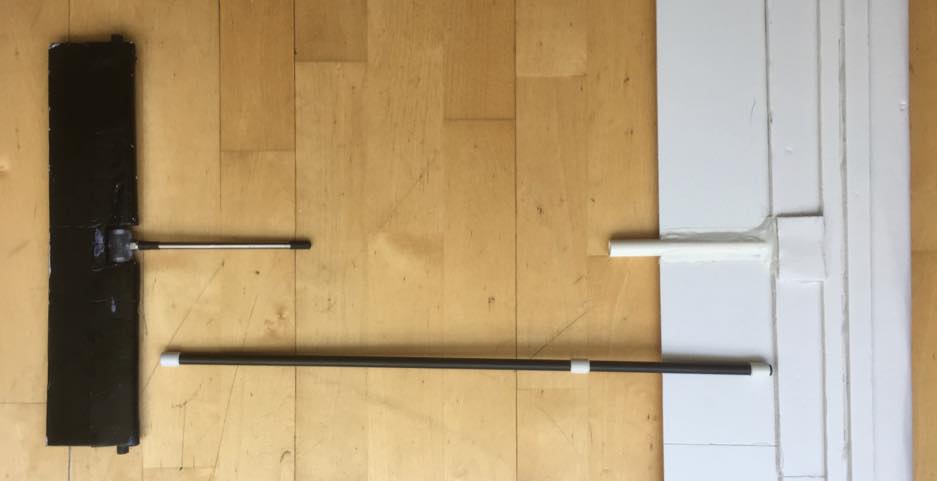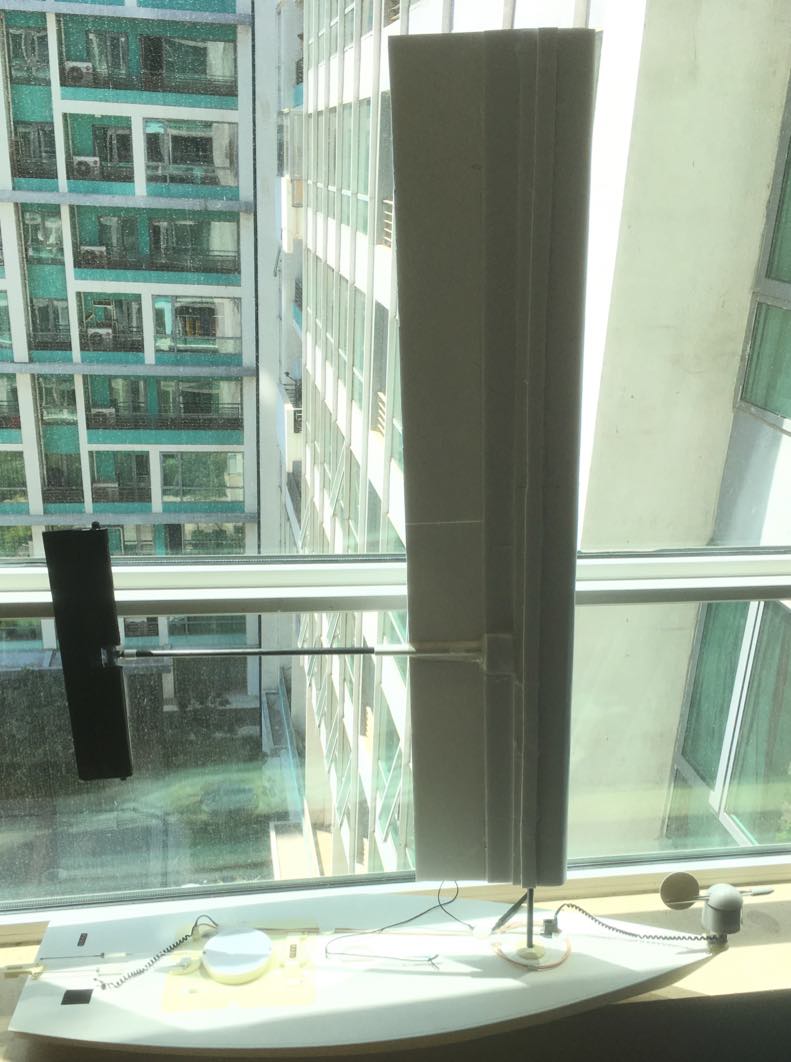Great to hear the new NMEA guy works noticeably better.
The motor mode seem giving great boat speed.
How do you control the thrust of motor? or maybe you don’t, just set it at some value and then on or off?
In manual mode you setup a aux RC option to control the sail and use the main throttle for the motor. In modes above manual it does it automaticaly based on a 3pos switch.
- Always sail, never use the motor
- Allow motoring, this uses a wind speed threshold to trigger the motor
- Always motor, this tuns off sailboat navigation and uses the motor
Hi, sharing some more design stuff.
Had to make some changes to the tail design to make it lighter.
Reason is that every single gram put out there will have 0.55 m leverage and needs to be balanced off on the front of the wing. So, made another design with lots less weight but also lots less stability. Still needs serious wight to balance it.
Since I just hate to put weight on that is just ballast, I prefer to redistribute the items that’s really needed in such a way it creates balance. Like motor, ESC, LiPi, Servo, Antenna.
Most of those guys are just put in a plastic box for now, inactive, but still
apply their weight.
I simply put the the angle control on a nob of the transmitter.
Deflection angle is around ± 30 degrees of the control tab.
Wing Sail test with rig 1 out of 3.
(+) can fit the wing sail in the blue bag for transportation
(+) if wind over 2 m/s then the control tab have have control over Wing angle
(-) light winds seems not fit for this type of wing/sail?
All in all - I am happy with the test. It’s working as expected for the control tab to be able to control angle of attack of the Wing.
I am sorry I need to go on a trip for 4 weeks getting back 23 July.
So cant do more testing until after that date.
looks really good, Thanks for building it! no worries about the delay, it will give me a chance to get the code done!
Thank God 
and thanks a million for all the coding you already done to the sailboat!
When I get back my NMEA instrument should also have arrived.
Hi folks.
Wow, reading some of these comments has been mind blowing! We are working on a boat with a group of young people as a tech challenge. It is a 1M Hurricane RC boat. I am a sailor but not a great techy and we are a bit stuck. Wondered if any of you could shed some light?
We have taken a slightly simplistic approach and have sort of committed to seeing the plan through given that the idea came from the group, should just about work, and - provided we can learn how to set some of the mission planner parameters and modes to the right values/settings - should get us round a triangle course which will be the challenge.
Our build consists of a Pixhawk 2.4.8 connected to mission planner. We then have an Arduino Uno which we have coded and connected to the wind vane (situated on top of the mast) and the two are designed to switch between them using a relay.
The basic principle we are applying is that the pixhawk will attempt to steer the boat around the way points using fixed sheeting (a massive compromise in know) Should the wind become unfavourable the arduino will kick in and take over control from the pixhawk. It will run a loop which essentially bears the boat away from the wind and sails for 5 seconds until then switching back to pixhawk and allowing it to try again for the way point.
I get how rudimentary this approach is, and that it is massively limiting in terms of sail trim, obstacles etc etc but… We are pressing ahead for now to try and realise the groups ideas.
Our problem is that as things stand we have absolutely no success in getting pixhawk to try and control the boat at all. Reading this thread tells me we need to look at getting it MP in the right flight mode. we are about to try Acro, auto and steering modes to see if that helps.
Also aware that we might not have steering/throttle servo control set up correctly in the parameters. As we only want to steer the boat at this stage and don’t want to control the sheets particularly, what would any of you suggest?
Thanks in advance! we are in the workshop all week this week trying to get the problem sorted. If anyone can chat on the phone I’m happy to share my number.
Ed
Welcome here Ed 
Lets await the gurus answers here,
but I just wonder why you complicate things with a pixhawk plus an Arduino Uno?
Why not just stick to one pixhawk controller?
It’s basically a case of the plan being formed prior to a lot of other understanding about how things work and what is possible and that fact that we still have some investment in the original idea. We were also handed the pixhawk and the arduino in the kit we were given at the start of the challenge and have only really discovered the potential of the pixhawk to ‘do it all’ in more recent times. plus the young people knew enough C++ to code the arduino so they have invested something in the coding and wiring of the whole thing now. There is a keen will to try and see our idea into reality but Wednesday is our deadline to make it work. Regardless we don’t have any success getting the pixhawk to control the boat at all with or without arduino plugged in. Just trying to get the pixhawk to control the servo! Something in settings isn’t right for us.
The rover wiki should have all in info you need to get the steering working in acro mode.
http://ardupilot.org/rover/index.html
I would recommend removing the Arduino if posible. You wind vane may be of a type that is already supported by the code directly.
http://ardupilot.org/rover/docs/wind-vane.html
You can even use a fixed wind direction or take it from a RC input. This might be a better place to start.
Fixed sheeting angle is not ideal but should work I think, just set your tacking angle quite large. SAIL_NO_GO_ANGLE of 60 or so.
Hmmm… Yes, in principle that sounds like a good plan but…
At the moment we have issues when it comes to arming to the pixhawk at all. We get repeated error codes. Error - command rejected by Mav. these are ‘pre-arm 3D accel calibration needed’ and ‘pre arm hardware safety switch’.
We don’t have a safety switch plugged in. in fact we don’t have one at all. We thought we’d got round this by setting the BRD_SAFETYENABLE value to 0. Do I need a safety switch?
We are trying this on acro mode. We are also unsure whether we should have servo 3 set to throttle or disabled given the fact we aren’t aiming to use the sheeting servo.
Can you think of any other reasons that i can’t arm the pixhawk?
no need to use a safety switch
You need to do a aceleromiter cal, this can be done using mission planner, Accelerometer Calibration — Rover documentation
You will have to have either throttle or a sail configured as one of the outputs, the code knows it needs some way of making progress. I suggest you configure the sail output, you don’t have to actually plug anything in, just have it setup.
So,
Found a safety switch, 3D calibration success. succesfully armed, mission started. No servo response.
In the servo output page, the ground steering value was suggesting it was trying to make a turn however the servo was not moving.
Wiring issue? Could it be anything else?
If the green bar is moving and you have the servo plugged into that channel then it is most likely a wiring issue, are you powering the servos from a separate bec?
no. all coming from the same power source. Currently as we are dry testing we are just using a portable power pack with separate 5v usb outputs to power the pixhawk and arduino units. We know that the arduino gets sufficient power from this to power the servo no problem.
We are just going through and disabling a load of fail safe actions atm as well as we have had a failsafe warning showing.
Also have directly wired the servo into the pixhawk to test. Arduino and relay no longer in the picture (for now!)
The pixhawk will not power the servo rail. i.e. if your powering the pixhawk from USB or with a inline power module there will be no power to the servo rail.
You will have to power the rail from directly, this could just be from the same 5v supply if it is up to it, but this is typically done with a dedicated bec
edit: see http://ardupilot.org/rover/docs/common-powering-the-pixhawk.html
Thanks for help today Peter.
finished for the day now. No joy yet but lots of learning and great team work from the young men involved. Back at it in the morning.
Thanks
Ed
About sail boats and rudder self-steering ![]()
I realize this is likely too late and also a bit premature but I think it’s relevant to autonomous sailbots, going forward, if not this, then maybe next summer GSoC ![]()
It’s closely related to your point 4. Wing sails with ‘elevator’ controls.
It should be possible to shut down the rudder servo and save all that energy by relying on a similar but not same setup, ‘a rudder tuning surface’ that will mechanically auto-balance the course in shifting winds.
The reference sailbot, discusses this (search the pdf with ‘self-steering’ or ‘steering’ finding the relevant parts).
They are very clear on
. What they want to do,
. Why they want to do it,
. Saying it was successful, but
as far as I can understand very vague on
How did they do it?
Anyway, this guy seems experienced (43 years) on this and talks about its only two main types of self-steering setups around. The fist one ‘Auxiliary rudder systems’, hope I got that right. Basically shutting down your default rudder system in favor of another one. And then second one like pendulum, ‘Integrated rudder system’, for sure did not get that one right. But I think we are interested in the first one anyways.
It will need a mechanical setup for sure but then also some tuning/setting the desired heading, capability of the autopilot.
Any thoughts on this topic anyone?
I think most of these drone ships don’t make a great VMG when conserving power. They take along time to get from point a to b. The boat rounds up into the wind then falls off and it moves along a lot slower than if it was being constantly steered. On a well balanced boat it will round up into the wind and then fall off and do a little scallop shaped bread crumb trail but need no input.

